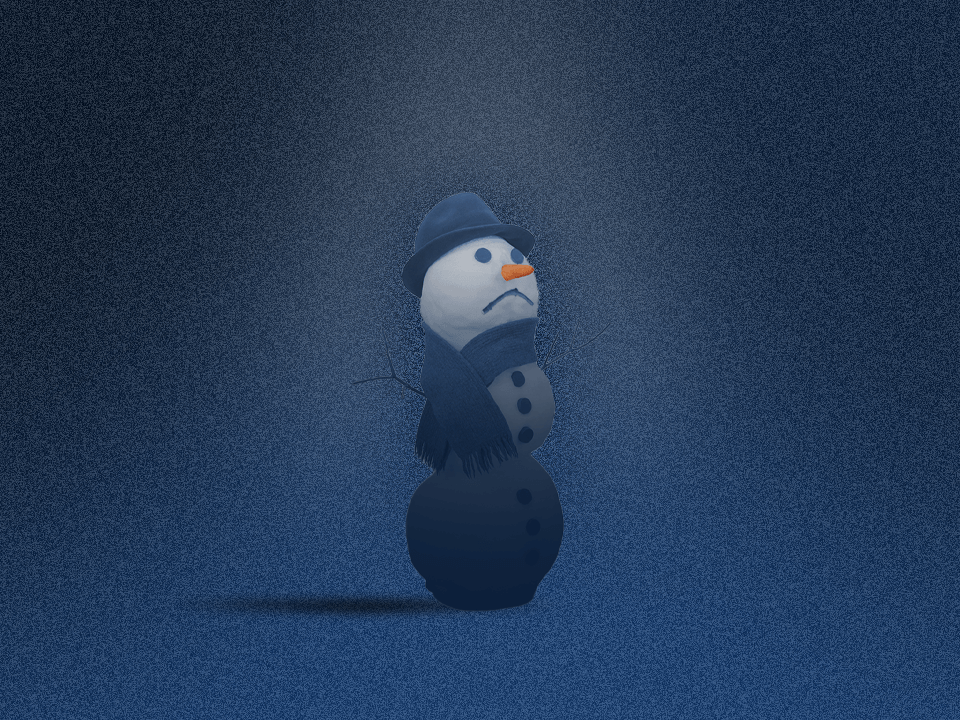5 Tips for a Less Terrible Seasonal Depression Szn
SAD doesn’t have to define your winter!
It’s normal to have winter blues. To feel blah when the weather gets cold and days are shorter. To want to hide under the covers and only come out once the flowers start doing their thing. Not everyone’s winter blues meet the criteria for seasonal depression—a type of clinical depression that comes back around year over year with an almost clockwork pattern—but if that’s what you’re dealing with, there are ways you can handle it on your own and with the support of trained clinicians.
People with seasonal depression, also called seasonal affective disorder (SAD), usually have depression symptoms in the fall and winter months that go away by the spring and summertime, says psychologist Kelly Rohan, PhD, a professor in the University of Vermont’s department of psychological science who studies SAD. So if you’re clinically depressed for at least two years in a row during the fall or winter and only seem to get better once spring…well…springs, that’s when you’d typically meet criteria for seasonal depression, or what the Diagnostic and Statistical Manual of Mental Disorders (DSM-5-TR) calls major depressive disorder with seasonal pattern.
For some people, this is just how and when their depression crops up (winter depression’s rude like that); for others, it may be how their depressive episodes show up with bipolar disorder (which can have a seasonal pattern too, according to the DSM-5-TR). Either way, SAD is a very real and very frustrating phenomenon.
The signs are pretty much the same as other types of depression. You lose interest in doing what you typically like doing (seeing friends, for example), you’re tired a lot and tend to sleep more than usual, you’re generally in a sad mood with feelings of worthlessness, and you’re hungrier than normal, says Dr. Rohan.
This type of depression may be triggered when shorter daylight periods in the wintertime cause your biological clock (circadian rhythm) to be out of whack, says clinical psychologist Sally Weinstein, PhD, associate director of the University of Illinois Center on Depression and Resilience. Having an out-of-sync biological clock affects how our bodies “make and regulate different key brain chemicals, or neurotransmitters like serotonin and melatonin, that have a huge role in our mood, our sleep cycles, and our energy levels,” explains Dr. Weinstein.
Millions of people in the U.S. may have SAD without knowing it, according to the National Institute of Mental Health (NIMH). It can run in families and is more common in people with fam members who have other mental health disorders, per the NIMH. So, if you think your winter blahs may actually be seasonal depression, trust that you’re not alone and that there are things you can do to feel less down. Maybe, just maybe, you’ll start to find winning moments in the wintertime. Here’s hoping.
1. Try to do more things you enjoy.
Even if it’s really hard to motivate yourself during the winter, doing stuff you enjoy can help boost your mood, energy, and overall well-being, Dr. Weinstein says. Finding joyful activities during these months is actually part of how therapists help people with SAD in cognitive behavioral therapy (CBT), notes Dr. Rohan.
If your go-to activities usually include planting lavish gardens, you’ll have to switch gears to something more weather appropriate like pickling or baking, but try it out! Think about scheduling time for activities that bring you joy as a form of self-care, says Dr. Weinstein.
Embracing good aspects of the season to shift your perspective on winter is another thing people tend to do in CBT, says Dr. Weinstein—and you can definitely test this out on your own. Find the fun in winter! Maybe you’re excited about hot chocolate, watching holiday movies, or bundling up in every warm blanket or sweater you own. Try one winter-y activity each week (yes, lighting that cozy new candle can totally count as an “activity”) and see if it impacts your mood, Dr. Weinstein suggests.
Sometimes you just have to fake it till you make it because nothing sounds fun when you’re depressed, Dr. Weinstein points out. Rather than waiting to feel that motivation, act as if you’re ready to go sledding or play around outside like it’s your own personal winterized beach. Then, go do it! See if your mood changes, and if it doesn’t, pick a different winter to-do. Your seasonal depression might not feel as heavy as the snowfall anymore.
2. Connect with others.
Spending time with people who support you and literally put a smile on your face may help with depression, particularly during the winter when you’re more likely to isolate yourself, Dr. Weinstein says. Establish a balance between curling up under a blanket and filling your calendar by designating a few hours per week to someone you like being around, she suggests.
While hanging out face to face is nice, calling, texting, or FaceTiming friends or fam also works, says Dr. Weinstein. Whatever helps you feel less alone and puts you in a better mood is fair game.
3. Lock down a routine you can stick with.
If March-to-October You usually goes to the gym a few times a week after work or meets friends every Wednesday for apps, see if you can keep up those activities in the dark winter months too. That can prevent you from falling into “hibernation mode,” where you withdraw from the world, says Dr. Rohan.
Though conserving your energy is helpful in the short-term, skipping activities that give you life and help you destress (working out, grabbing dinner with great company, journaling, whatever it may be) can prolong depression, Dr. Rohan says. And the sooner you're proactive, the better. “It’s so much easier to try to interrupt the cycle early on than to dig yourself out once you're fully into it,” she explains.
And make sure you’re penciling in self-care activities too, Dr. Weinstein notes. If that means scheduling a bubble bath or watching one or two more episodes of the show you’re into before bed, that’s totally fine.
4. Try light therapy or something like it.
Research suggests that daily exposure to very bright artificial light—aka light therapy—is an effective treatment for SAD. Throughout the season, you typically sit in front of a light box that simulates dawn for at least 30 minutes first thing in the morning, says Dr. Rohan. “It's thought that the bright light may improve mood and counteract the effects of seasonal affective disorder by either fixing or reversing some of those brain changes that we believe are affected by the change in daylight,” Dr. Weinstein explains. Basically, light therapy is thought to jumpstart your circadian clock (if it’s running slow) and shut off sleep-friendly melatonin production, Dr. Rohan further explains.
FYI: Light therapy isn’t regulated by the FDA, which means there are tons of different light boxes online, Dr. Rohan notes. Typically, you should choose ones that emit cool, white fluorescent light with an intensity of 10,000 lux and without UV rays, since those rays can hurt your skin and eyes, she says. A light box that meets these standards is similar to the ones used in clinical trials, she adds. You can browse recommendations from Yale University’s Winter Depression Research Clinic.
If you’re unsure that light therapy is helping, Dr. Rohan suggests seeing a doctor to talk about what dose of light is right for you based on how much your mood changes. You’ll also want to check in with a doctor first if you have any kind of eye condition or retinal sensitivity, says Dr. Weinstein.
Another option? Consistently spending 30 minutes outside in the sun each day—ideally in the morning—to help keep that circadian rhythm on schedule. You can get just as much light—or more!—from the sky on a clear day than you would via light therapy, says Dr. Rohan. If you spend that 30 minutes walking, you might also get in on some feel-good endorphins and distract yourself from your bad mood, she adds. If you can’t go outside in the morning, a 10-minute sesh in the afternoon works too, suggests Dr. Weinstein. Just, you know, take a look at the temp outside first and dress appropriately.
5. Ask for help.
Regardless of whether your symptoms meet the criteria for seasonal depression or are more in winter blahs territory, if you feel like you could use some help with life in the wintertime, ask for it. Don't feel like you need to hit some specific threshold of suffering in order to reach out. Getting help could mean calling up your support system, talking to your primary care provider about changes in your body you might be noticing, or booking an appointment with a licensed mental health pro to unpack your winter-hating mindset.
Treatment for SAD usually involves the aforementioned CBT, which Dr. Rohan calls a tried-and-true depression treatment. CBT for SAD typically focuses on pinpointing the negative thoughts that tend to be loudest this time of year and learning to challenge them, she says. So, if you’re thinking, Argh, I feel so much less productive in the winter! a therapist might ask you to find evidence for why that’s true, she adds. What does getting things done in the winter look like versus the summer? Are other factors impacting your productivity aside from what season it is? This way, you can try to shift your mindset to be more realistic so you’re not associating all of this negativity with winter months.
Dr. Rohan found in her research that 12 sessions of CBT can help people with SAD—even after treatment ends. In fact, she’s found that people who went through CBT treatment have fewer relapses of SAD and less severe symptoms post treatment compared to those who received light therapy alone.
If you’re interested in CBT, look for a mental health pro who’s experienced in treating depression, suggests Dr. Rohan. You can start on the Anxiety and Depression Association of America website or on Psychology Today.
For some, treating seasonal depression might involve the same antidepressants (SSRIs) used to treat major depressive disorder, says Dr. Rohan. Also, the FDA has approved a different kind of antidepressant, bupropion, which, when taken daily from the fall until spring, can prevent seasonal depression, according to the NIMH. Depending on your symptoms, you may want to give therapy and meds a go or try one over the other. The key is talking to your providers and locking down what works for you.
Seasons happen within us and in nature. Seriously, we can always count on it! But you don’t have to let the winter run its course without doing anything about your seasonal depression, even if you suspect it will pass eventually. Listen, it’s fine if you’re not so merry every winter, but if your mood consistently tanks this time of year and it ends up really messing with your life, know that you don’t have to suffer in silence.
Wondermind does not provide medical advice, diagnosis, or treatment. Any information published on this website or by this brand is not intended as a replacement for medical advice. Always consult a qualified health or mental health professional with any questions or concerns about your mental health.




